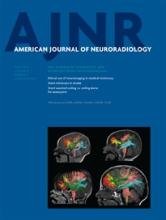Index by author
Faa, G.
- Extracranial VascularYou have accessCorrelation between Fissured Fibrous Cap and Contrast Enhancement: Preliminary Results with the Use of CTA and Histologic ValidationL. Saba, E. Tamponi, E. Raz, L. Lai, R. Montisci, M. Piga and G. FaaAmerican Journal of Neuroradiology April 2014, 35 (4) 754-759; DOI: https://doi.org/10.3174/ajnr.A3759
Ferrara, M.J.
- Health Care Reform VignetteYou have accessBudget Sequester: Potential Impact on Health Care ProvidersM.J. FerraraAmerican Journal of Neuroradiology April 2014, 35 (4) 657-659; DOI: https://doi.org/10.3174/ajnr.A3726
Fieremans, E.
- PediatricsYou have accessDiffusional Kurtosis Imaging of the Developing BrainA. Paydar, E. Fieremans, J.I. Nwankwo, M. Lazar, H.D. Sheth, V. Adisetiyo, J.A. Helpern, J.H. Jensen and S.S. MillaAmerican Journal of Neuroradiology April 2014, 35 (4) 808-814; DOI: https://doi.org/10.3174/ajnr.A3764
Fletcher, G.P.
- Patient SafetyYou have accessRadiation Dose Reduction in Paranasal Sinus CT Using Model-Based Iterative ReconstructionJ.M. Hoxworth, D. Lal, G.P. Fletcher, A.C. Patel, M. He, R.G. Paden and A.K. HaraAmerican Journal of Neuroradiology April 2014, 35 (4) 644-649; DOI: https://doi.org/10.3174/ajnr.A3749
Gascou, G.
- InterventionalYou have accessStent Retrievers in Acute Ischemic Stroke: Complications and Failures during the Perioperative PeriodG. Gascou, K. Lobotesis, P. Machi, I. Maldonado, J.F. Vendrell, C. Riquelme, O. Eker, G. Mercier, I. Mourand, C. Arquizan, A. Bonafé and V. CostalatAmerican Journal of Neuroradiology April 2014, 35 (4) 734-740; DOI: https://doi.org/10.3174/ajnr.A3746
Ge, S.G.
- FELLOWS' JOURNAL CLUBInterventionalOpen AccessStent-Assisted Coiling versus Coiling Alone in Unruptured Intracranial Aneurysms in the Matrix and Platinum Science Trial: Safety, Efficacy, and Mid-Term OutcomesS.W. Hetts, A. Turk, J.D. English, C.F. Dowd, J. Mocco, C. Prestigiacomo, G. Nesbit, S.G. Ge, J.N. Jin, K. Carroll, Y. Murayama, A. Gholkar, S. Barnwell, D. Lopes, S.C. Johnston and C. McDougall on behalf of the Matrix and Platinum Science Trial InvestigatorsAmerican Journal of Neuroradiology April 2014, 35 (4) 698-705; DOI: https://doi.org/10.3174/ajnr.A3755
These authors analyzed data on 131 non-selected MCA aneurysms treated during a 6-year period. One month after treatment, permanent morbidity and mortality was 3.3% without significant differences according to technique used. The rate of recanalization was nearly 16%, also without differences according to technique, and re-treatment was needed in 7.6% of cases. A greater rate of complications occurred with balloon remodeling and only large aneurysm size predicted recanalization. The authors concluded that endovascular treatment of MCA aneurysms is safe, effective, and durable.
Gholkar, A.
- FELLOWS' JOURNAL CLUBInterventionalOpen AccessStent-Assisted Coiling versus Coiling Alone in Unruptured Intracranial Aneurysms in the Matrix and Platinum Science Trial: Safety, Efficacy, and Mid-Term OutcomesS.W. Hetts, A. Turk, J.D. English, C.F. Dowd, J. Mocco, C. Prestigiacomo, G. Nesbit, S.G. Ge, J.N. Jin, K. Carroll, Y. Murayama, A. Gholkar, S. Barnwell, D. Lopes, S.C. Johnston and C. McDougall on behalf of the Matrix and Platinum Science Trial InvestigatorsAmerican Journal of Neuroradiology April 2014, 35 (4) 698-705; DOI: https://doi.org/10.3174/ajnr.A3755
These authors analyzed data on 131 non-selected MCA aneurysms treated during a 6-year period. One month after treatment, permanent morbidity and mortality was 3.3% without significant differences according to technique used. The rate of recanalization was nearly 16%, also without differences according to technique, and re-treatment was needed in 7.6% of cases. A greater rate of complications occurred with balloon remodeling and only large aneurysm size predicted recanalization. The authors concluded that endovascular treatment of MCA aneurysms is safe, effective, and durable.
Glastonbury, C.M.
- Head & NeckYou have accessCraniopharyngeal Canal and Its Spectrum of PathologyT.A. Abele, K.L. Salzman, H.R. Harnsberger and C.M. GlastonburyAmerican Journal of Neuroradiology April 2014, 35 (4) 772-777; DOI: https://doi.org/10.3174/ajnr.A3745
- EDITOR'S CHOICEHead & NeckYou have accessSpontaneous Lateral Sphenoid Cephaloceles: Anatomic Factors Contributing to Pathogenesis and Proposed ClassificationF. Settecase, H.R. Harnsberger, M.A. Michel, P. Chapman and C.M. GlastonburyAmerican Journal of Neuroradiology April 2014, 35 (4) 784-789; DOI: https://doi.org/10.3174/ajnr.A3744
Imaging findings in 26 patients with spontaneous lateral sphenoid cephaloceles were studied. The authors were able to classify these lesions into those involving the lateral recess of the sphenoid sinus that typically manifested as CSF leaks and headaches, and a second type that involved the lateral sphenoidal wing without extension into the sinus and presented with a variety of findings including seizures, headaches, meningitis, or neuropathy, or were incidental. All patients showed sphenoid arachnoid pits and 61% had an empty or partially empty sella.
Gory, B.
- InterventionalYou have accessEndovascular Treatment of Middle Cerebral Artery Aneurysms for 120 Nonselected Patients: A Prospective Cohort StudyB. Gory, A. Rouchaud, S. Saleme, F. Dalmay, R. Riva, F. Caire and C. MounayerAmerican Journal of Neuroradiology April 2014, 35 (4) 715-720; DOI: https://doi.org/10.3174/ajnr.A3781
Goyal, M.
- EditorialsYou have accessAcute Stroke Intervention Results: The “Denominator” FallacyM. GoyalAmerican Journal of Neuroradiology April 2014, 35 (4) 616-618; DOI: https://doi.org/10.3174/ajnr.A3770
- FELLOWS' JOURNAL CLUBBrainOpen AccessDWI Reversal Is Associated with Small Infarct Volume in Patients with TIA and Minor StrokeN. Asdaghi, B.C.V. Campbell, K.S. Butcher, J.I. Coulter, J. Modi, A. Qazi, M. Goyal, A.M. Demchuk and S.B. CouttsAmerican Journal of Neuroradiology April 2014, 35 (4) 660-666; DOI: https://doi.org/10.3174/ajnr.A3733
The implications of the reversal of DWI abnormalities in patients with TIA and minor strokes were assessed. Patients were imaged within 24 hours of symptoms and followed for 3 months and baseline and final infarct volumes were calculated using DWI and FLAIR, respectively. Over 55% of patients had DWI lesions and 37% had perfusion deficits. DWI reversal occurred in 6% of patients with lesion volume being considerably smaller than in those that did not reverse. Perfusion abnormalities were less common in reversible lesions as well. The authors concluded that DWI lesion reversal is uncommon and more likely with smaller lesions.








